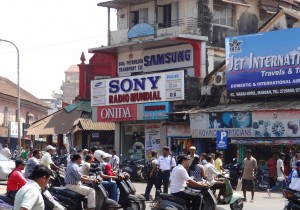 My son Andrew Sloman (see also) is currently in Goa. My wife Alison and I went to visit him over half term – our first trip to India. Goa is a beautiful state, with wonderful beaches, fantastic food and perfect weather in February. But inland from this tourist haven lies an environmental disaster caused by the open-cast extraction of iron ore.
My son Andrew Sloman (see also) is currently in Goa. My wife Alison and I went to visit him over half term – our first trip to India. Goa is a beautiful state, with wonderful beaches, fantastic food and perfect weather in February. But inland from this tourist haven lies an environmental disaster caused by the open-cast extraction of iron ore.
This tiny state by Indian standards produces more than 60% of India’s iron ore exports. Whilst, along with tourism, the iron ore industry has been one of the largest contributors to the Goan economy, its environmental footprint is massive. Deforestation and water and air pollution are just three of the environmental externalities.
So should a cap be placed on the amount of iron ore that is mined? Should the industry be taxed more heavily? Should tough environmental standards be imposed on the industry? Or should it simply be allowed to continue, given its large contribution to the Goan economy? Or, at the other extreme, should the industry be closed? The linked article looks at some of the issues. Try to identify, as an economist, what information you would require in order to come to a conclusion to these questions.
Greens’ shout for cap on iron ore mining falls on deaf ears Times of India, Paul Fernandes (28/2/12)
Questions
- What negative externalities are involved with the Goan iron ore industry? Are there any positive externalities?
- What difficulties are there in measuring the negative externalities?
- How would you set about doing a cost–benefit analysis of (a) expanding the Goan iron ore industry; (b) shutting it?
- Explain the following: “The net present value of the opportunity cost for 25 years at 12% social discount rate of giving it up is greater than its environmental cost by Rs 14,449 crore, the report states.” (A crore is 10 million and Rs is the symbol for an Indian Rupee, where £1 = approximately 78 rupees.)
- What difficulties are there in attempting to take distribution into account when doing a cost–benefit analysis?